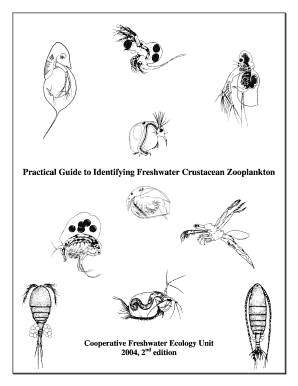
Practical Guide to Identifying Freshwater Crustacean Zooplankton Form


What is the practical guide to identifying freshwater crustacean zooplankton?
The practical guide to identifying freshwater crustacean zooplankton serves as a comprehensive resource for researchers, educators, and enthusiasts interested in the microscopic world of aquatic life. This guide provides detailed descriptions and visual aids to help users recognize various species of crustacean zooplankton commonly found in freshwater environments. It covers key characteristics such as size, shape, and coloration, enabling accurate identification. By utilizing this guide, individuals can enhance their understanding of aquatic ecosystems and contribute to biodiversity studies.
How to use the practical guide to identifying freshwater crustacean zooplankton
Using the practical guide involves several straightforward steps. First, familiarize yourself with the layout of the guide, which typically includes sections organized by species or taxonomic groups. Next, when you encounter a specimen, compare its physical traits to the illustrations and descriptions provided in the guide. Pay attention to distinguishing features such as appendages, body segments, and specific markings. It may also be helpful to use a magnifying glass or microscope for better visibility. Document your findings to support any research or educational projects.
Key elements of the practical guide to identifying freshwater crustacean zooplankton
The practical guide includes several essential elements that enhance its usability. These elements often consist of:
- Illustrations and Photographs: High-quality images that depict various species for easy comparison.
- Identification Keys: Step-by-step guides that assist users in narrowing down species based on observable characteristics.
- Habitat Information: Details about the typical environments where specific zooplankton species are found.
- Life Cycle Stages: Information on the developmental stages of zooplankton, which can aid in identifying them at different life phases.
Steps to complete the practical guide to identifying freshwater crustacean zooplankton
Completing the identification process involves a systematic approach. Follow these steps:
- Collect a water sample from a freshwater source, ensuring minimal disturbance to the habitat.
- Use a fine mesh net to filter out zooplankton from the sample.
- Transfer the collected organisms to a petri dish or slide for closer examination.
- Refer to the practical guide, using the identification keys and illustrations to match the specimens.
- Record your observations, including species names and any notable characteristics.
Legal use of the practical guide to identifying freshwater crustacean zooplankton
When utilizing the practical guide for educational or research purposes, it is important to adhere to relevant legal and ethical standards. This includes obtaining necessary permits for collecting specimens from natural habitats, especially in protected areas. Additionally, ensure that any data collected is used responsibly and shared in compliance with local regulations regarding biodiversity and conservation. Proper citation of the guide in academic work is also essential to respect intellectual property rights.
Examples of using the practical guide to identifying freshwater crustacean zooplankton
There are numerous applications for the practical guide in various contexts. For instance:
- Educational Settings: Teachers can incorporate the guide into science curricula, allowing students to engage in hands-on learning about aquatic ecosystems.
- Research Projects: Scientists may use the guide to identify zooplankton for ecological studies, contributing to our understanding of food webs and environmental health.
- Citizen Science: Enthusiasts can participate in local monitoring programs, using the guide to report findings and assist in conservation efforts.
Quick guide on how to complete plankton identification guide
Complete plankton identification guide seamlessly on any device
Digital document management has become increasingly popular among companies and individuals. It serves as an ideal environmentally friendly alternative to traditional printed and signed documents, allowing you to find the right form and securely store it online. airSlate SignNow provides all the tools necessary to create, edit, and electronically sign your documents swiftly without delays. Manage plankton identification guide on any device using the airSlate SignNow Android or iOS applications and enhance any document-focused process today.
How to modify and electronically sign plankton identification guide effortlessly
- Find plankton identification guide and click Get Form to commence.
- Use the tools we provide to complete your form.
- Emphasize relevant sections of your documents or hide sensitive information with tools available from airSlate SignNow specifically for that intention.
- Create your electronic signature with the Sign feature, which takes mere seconds and carries the same legal validity as a conventional wet ink signature.
- Review all the details and then click the Done button to store your changes.
- Choose your preferred method of delivering your form, whether by email, text message (SMS), or invite link, or download it to your computer.
Eliminate the hassle of lost or mislaid files, tedious form searching, or errors that necessitate printing new document copies. airSlate SignNow meets your document management needs in just a few clicks from any device you choose. Edit and electronically sign plankton identification guide while ensuring excellent communication at every stage of your form preparation process with airSlate SignNow.
Create this form in 5 minutes or less
Related searches to plankton identification guide
Create this form in 5 minutes!
How to create an eSignature for the plankton identification guide
How to create an electronic signature for a PDF online
How to create an electronic signature for a PDF in Google Chrome
How to create an e-signature for signing PDFs in Gmail
How to create an e-signature right from your smartphone
How to create an e-signature for a PDF on iOS
How to create an e-signature for a PDF on Android
People also ask plankton identification guide
-
What is the plankton identification guide offered by airSlate SignNow?
The plankton identification guide by airSlate SignNow is an easy-to-use tool designed to help users effectively identify various types of plankton. This guide provides detailed information on plankton characteristics, habitats, and identification techniques, making it an essential resource for students, researchers, and marine enthusiasts.
-
How can the plankton identification guide benefit my research?
Utilizing the plankton identification guide enhances your research by supplying accurate and comprehensive information on plankton species. This guide aids in speeding up the identification process, which can dramatically improve the reliability of your data collection and analyses in marine studies.
-
What features are included in the plankton identification guide?
The plankton identification guide includes extensive visual aids, descriptions of various plankton types, and interactive elements for a more engaging learning experience. Additionally, the guide offers search capabilities and categorization to help users find specific plankton information quickly and efficiently.
-
Is there a cost associated with the plankton identification guide?
Yes, there is a nominal fee for accessing the comprehensive plankton identification guide offered by airSlate SignNow. Pricing details can be found on our website, and we offer various subscription plans to fit different budget needs.
-
Can I access the plankton identification guide on multiple devices?
Absolutely! The plankton identification guide is accessible on various devices including desktops, tablets, and smartphones. This flexibility allows you to identify plankton conveniently in the field or in your laboratory while on-the-go.
-
Does the plankton identification guide integrate with other tools?
Yes, the plankton identification guide is designed to seamlessly integrate with other research tools and software used for marine studies. These integrations enhance usability and streamline your research workflow without any disruptions.
-
How frequently is the plankton identification guide updated?
The plankton identification guide is regularly updated to ensure that it contains the most accurate and current information on plankton species. Users can expect periodic updates that reflect the latest research trends and discoveries in marine biology.
Get more for plankton identification guide
- Hawaii agreement to subleasesublet templates free download form
- Free virginia roommate agreement room rental form pdf
- Free alabama lease to own option to purchase agreement form
- Free florida rental application form pdf eforms free
- Real estate transactions for corporate counsel association form
- Free kansas power of attorney formspdf templates
- Ohio 30 day notice to quit health safety hazarddocx form
- Free south dakota rental lease agreements eforms
Find out other plankton identification guide
- eSignature South Carolina Insurance Stock Certificate Later
- eSignature Oregon High Tech NDA Easy
- How To eSignature South Carolina Insurance Stock Certificate
- How Do I eSignature South Carolina Insurance Stock Certificate
- eSignature South Carolina Insurance Stock Certificate Myself
- eSignature Oregon High Tech NDA Safe
- Help Me With eSignature South Carolina Insurance Stock Certificate
- How Can I eSignature South Carolina Insurance Stock Certificate
- Can I eSignature South Carolina Insurance Stock Certificate
- eSignature South Carolina Insurance Stock Certificate Free
- eSignature South Carolina Insurance Separation Agreement Online
- eSignature South Carolina Insurance Separation Agreement Computer
- eSignature South Carolina Insurance Stock Certificate Secure
- eSignature South Carolina Insurance Separation Agreement Mobile
- eSignature South Carolina Insurance Emergency Contact Form Online
- eSignature South Carolina Insurance Separation Agreement Now
- eSignature South Carolina Insurance Separation Agreement Later
- eSignature South Carolina Insurance Stock Certificate Fast
- eSignature South Carolina Insurance Emergency Contact Form Computer
- eSignature South Carolina Insurance Separation Agreement Myself